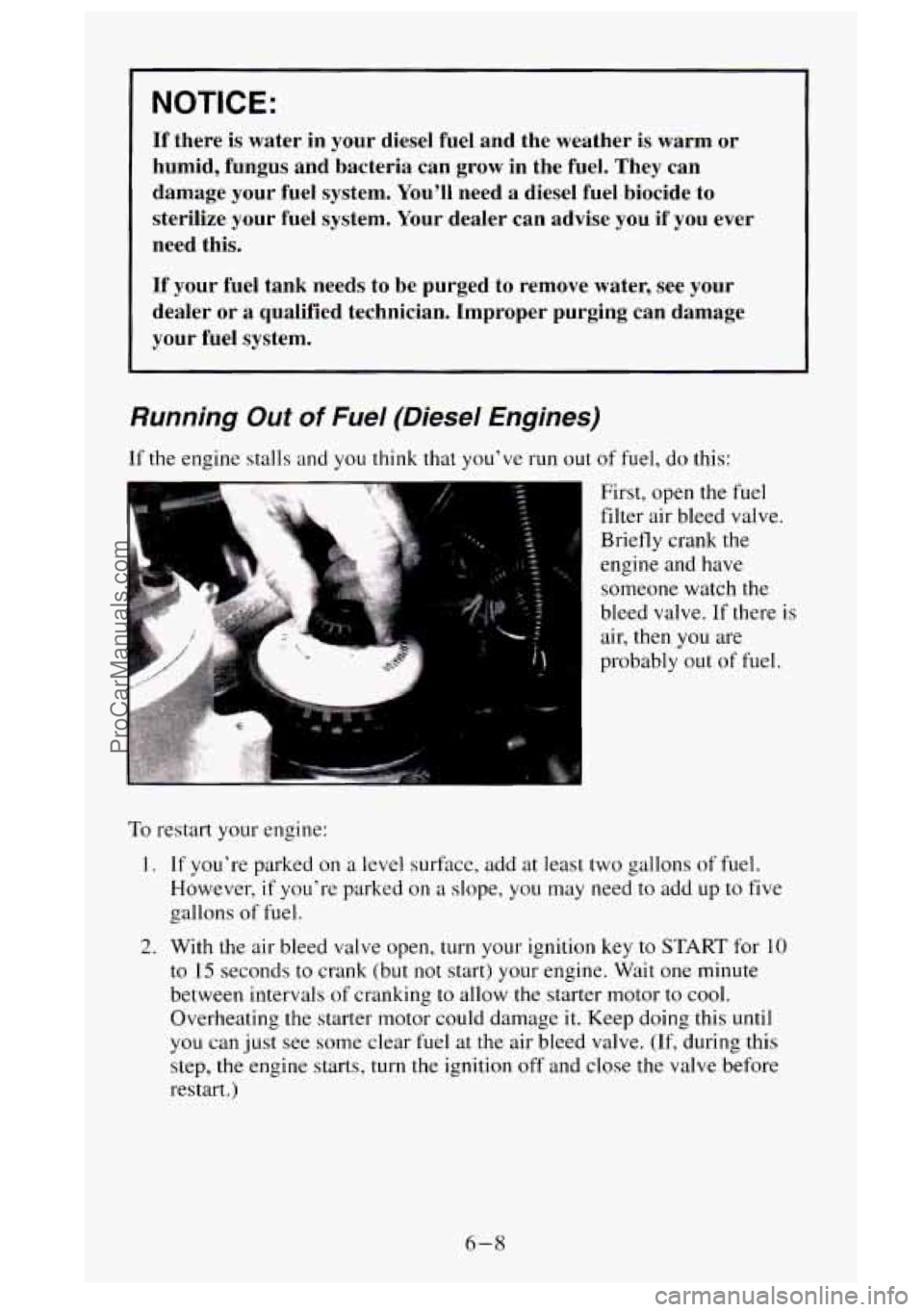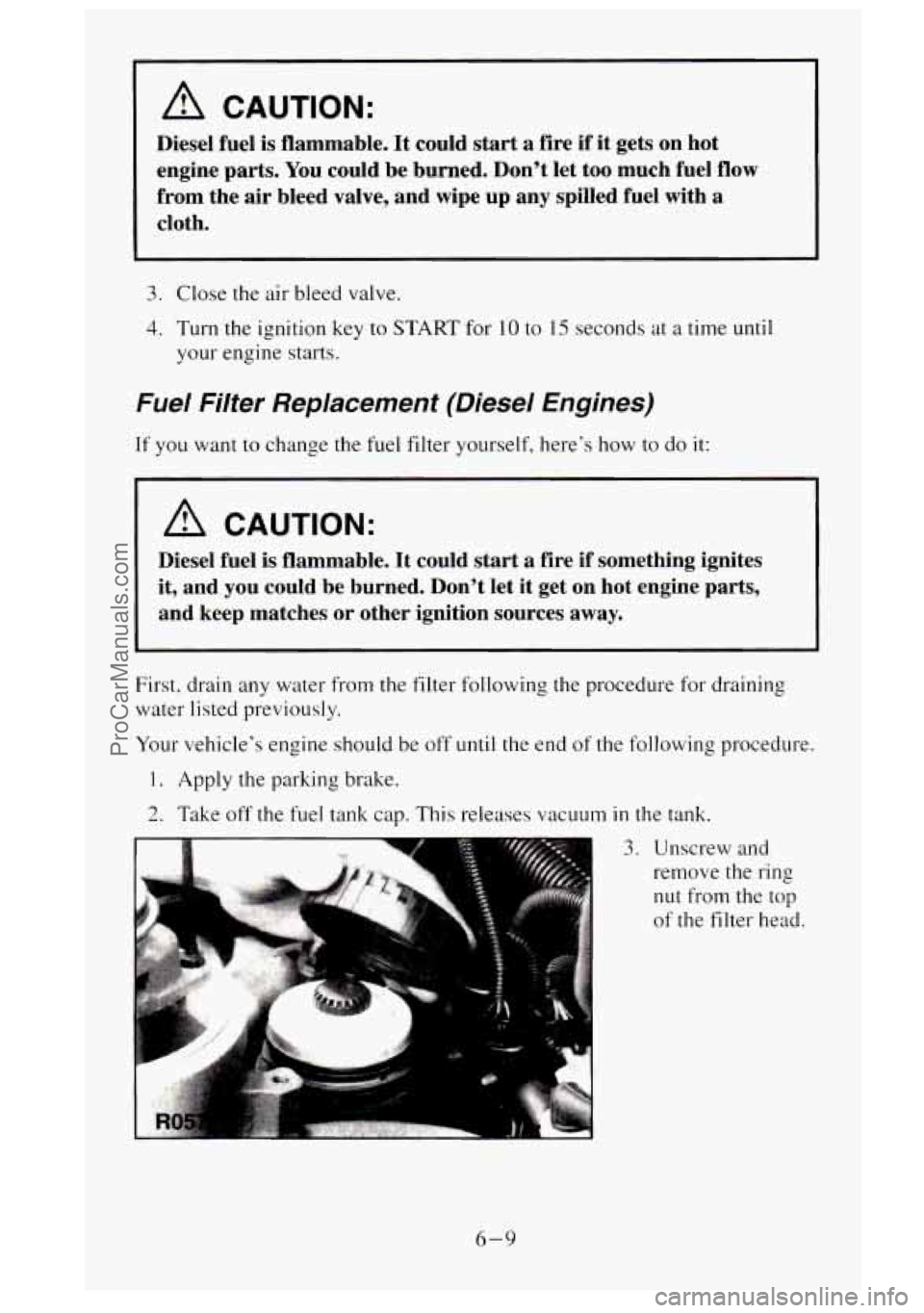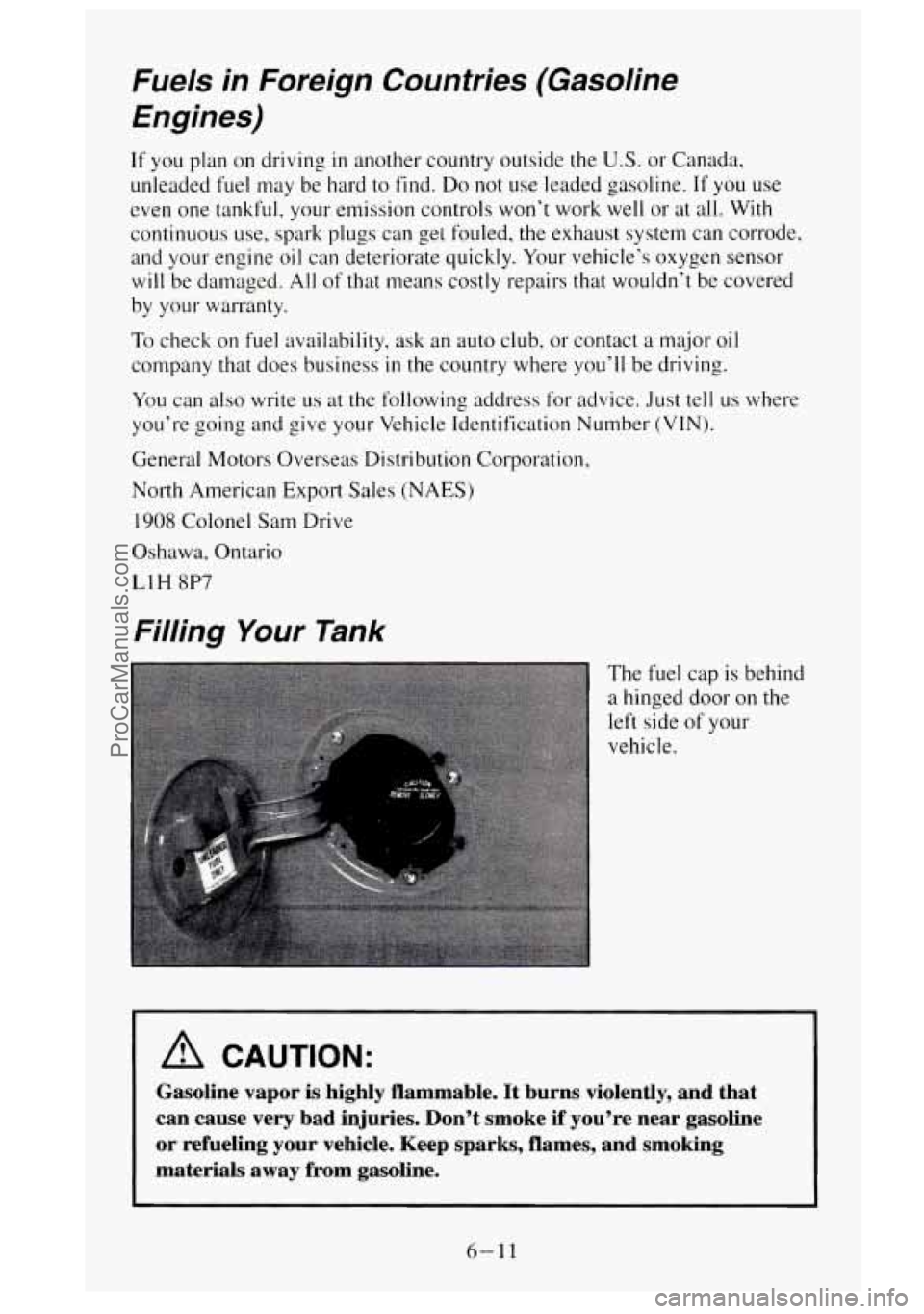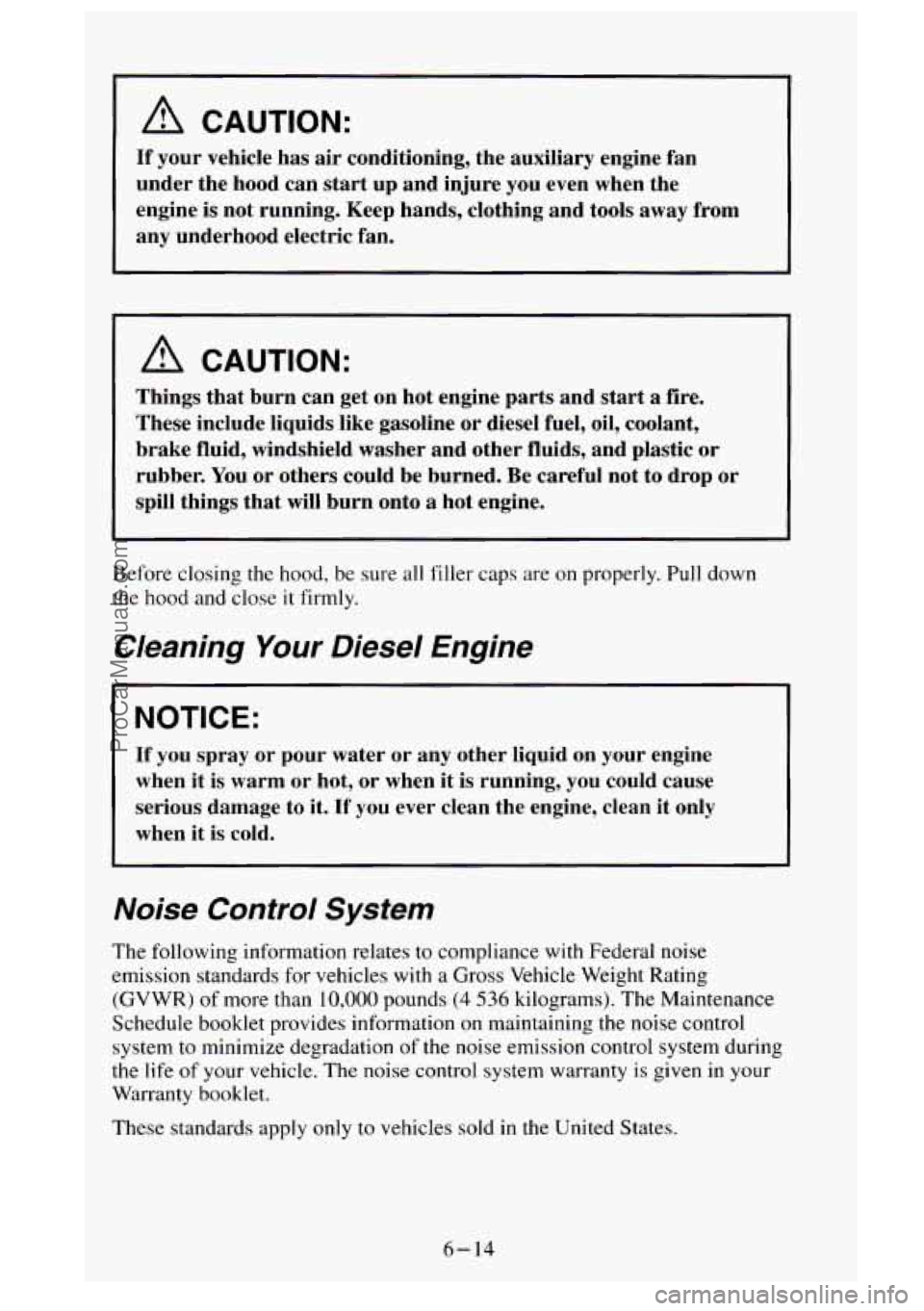Page 274 of 488

NOTICE:
If there is water in your diesel fuel and the weather is warm or
humid, fungus and bacteria can grow in the fuel. They can
damage your fuel system. You'll need a diesel fuel biocide to
sterilize your fuel system. Your dealer can advise
you if you ever
need this.
If your fuel tank needs to be purged to remove water, see your
dealer or a qualified technician. Improper purging can damage
your fuel system.
Running Out of Fuel (Diesel Engines)
If the engine stalls and you think that you've run out of fuel, do this:
First, open the fuel filter air bleed valve.
Briefly crank the
engine and have
someone watch the
bleed valve. If there is
air, then you are
probably
out of fuel.
To restart your engine:
I. If you're parked on a level surface, add at least two gallons of fuel.
However, if you're parked
on a slope, you may need to add up to five
gallons of fuel.
2. With the air bleed valve open, turn your ignition key to START for 10
to
15 seconds to crank (but not start) your engine. Wait one minute
between intervals
of cranking to allow the starter motor to cool.
Overheating the starter motor could damage it. Keep doing this until
you can just see some clear fuel at the air bleed valve. (If, during this
step, the engine starts, turn the ignition off and close the valve before
restart.)
6-8
ProCarManuals.com
Page 275 of 488

A CAUTION:
Diesel fuel is flammable. It could start a fire if it gets on hot
engine parts. You could be burned. Don't let too much fuel flow
from the air bleed
valve, and wipe up any spilled fuel with a
cloth.
3. Close the air bleed valve.
4. Turn the ignition key to START for 10 to 15 seconds at a time until
your engine starts.
Fuel Filter Replacement (Diesel Engines)
If you want to change the fuel filter yourself, here's how to do it:
A CAUTION:
Diesel fuel is flammable. It could start a fire if something ignites
it, and you could be burned. Don't let it get on hot engine parts,
and keep matches or other ignition sources away.
First. drain any water from the filter following the procedure for draining
water listed previously.
Your vehicle's engine should be off until the end
of the following procedure.
1. Apply the parking brake.
2. Take off the fuel tank cap. This releases vacuum in the tank.
3. Unscrew and
remove the ring
nut from the top
of the
filter head.
6-9
ProCarManuals.com
Page 276 of 488
7.
8.
9.
10.
4. Lift the element
out
of the filter
head.
5. If there is any dirt
on the element
sealing surface
of
the filter head,
clean
it off.
6. Line up the
widest slot in the
top of the new
element with
the
widest key on
then top of the
filter head. Push
the element in
until the mating
surfaces touch.
Replace and tighten the ring
nut to the top of the filter head
With
the air bleed valve open, turn your ignition key to START for 10
to 15 seconds. Wait one minute for your starter to cool. Do this until
you can see clear fuel coming from the air bleed valve.
Close the air bleed valve and replace the fuel cap.
Start your engine and let it idle for five minutes. Check your
fuel filter
and air bleed valve for leaks.
6- 10
ProCarManuals.com
Page 277 of 488

Fuels in Foreign Countries (Gasoline Engines)
If you plan on driving in another country outside the U.S. or Canada,
unleaded fuel may be hard to find.
Do not use leaded gasoline. If you use
even one tankful, your emission controls won’t work well or at all. With
continuous use, spark plugs can get fouled, the exhaust system can corrode,
and your engine
oil can deteriorate quickly. Your vehicle’s oxygen sensor
will be damaged.
All of that means costly repairs that wouldn’t be covered
by your warranty.
To check on fuel availability, ask an auto club, or contact a major oil
company that does business in the country where you’ll be driving.
You can also write
us at the following address for advice. Just tell us where
you’re going and give your Vehicle Identification Number
(VIN).
General Motors Overseas Distribution Corporation,
North American Export Sales (NAES)
1908 Colonel Sam Drive
Oshawa, Ontario
LlH 8P7
Filling Your Tank
The fuel cap is behind
a hinged door on
the
left side of your
vehicle.
A CAUTION:
Gasoline vapor is highly flammable. It burns violently, and that
can cause very bad injuries. Don’t smoke
if you’re near gasoline
or refueling your vehicle. Keep sparks, flames, and smoking
materials away from gasoline.
6-11
ProCarManuals.com
Page 278 of 488
While refueling, hang
the cap inside the fuel
door.
To take off the cap, turn it slowly to the left (counterclockwise).
-~
A CAUTION:
If you get gasoline on yourself and then something ignites it, you
could be badly burned. Gasoline can spray out on you if you
1 open the fuel filler cap too quickly. This spray can happen if
your tank is nearly full, and
is more likely in hot weather. Open
the
fuel filler cap slowly and wait for any “hiss” noise to stop.
Then unscrew the cap all the way.
Be careful not to spill gasoline. Clean gasoline from painted surfaces as
soon as possible. See “Cleaning the Outside of Your Vehicle” in the Index.
When
you put the cap back on, turn it to the right until you hear a clicking
noise.
1 NOTICE:
If you need a new cap, be sure t.0 get the right type. Your dealer
can get one for you.
If you get the wrong type, it may not fit or
have proper venting, and your fuel tank and emissions system
might be damaged.
6- 12
ProCarManuals.com
Page 280 of 488

A CAUTION:
If your vehicle has air conditioning, the auxiliary engine fan
under the hood can start up and injure you even when the
engine is not running. Keep hands, clothing and tools
away from
any underhood electric fan.
A CAUTION:
Things that burn can get on hot engine parts and start a fire.
These include liquids like gasoline or diesel fuel, oil, coolant,
brake fluid, windshield washer and other fluids, and plastic
or
rubber. You or others could be burned. Be careful not to drop or
spill things that
will burn onto a hot engine.
Before closing the hood, be sure
all filler caps are on properly. Pull down
the
hood and close it firmly.
Cleaning Your Diesel Engine
I NOTICE:
If you spray or pour water or any other liquid on your engine
when it is warm or hot, or when it
is running, you could cause
serious damage to it.
If you ever clean the engine, clean it only
when it is cold.
Noise Control System
The following information relates to compliance with Federal noise
emission standards for vehicles with a Gross Vehicle Weight Rating
(GVWR)
of more than 10,000 pounds (4 536 kilograms). The Maintenance
Schedule booklet provides information on maintaining
the noise control
system to minimize degradation of the noise emission control system during
the life of your vehicle. The noise control system warranty is given in your
Warranty booklet.
These standards apply only
to vehicles sold in the United States.
6-14
ProCarManuals.com
Page 282 of 488
Engine Oil (Gasoline Engines)
It’s a good idea to check your engine oil every time you get fuel. In order to
get an accurate reading, the oil must be warm and the vehicle must be on
level ground.
Turn
off the engine
and give the oil
a few
minutes to drain back
into the oil pan.
If you
don’t, the
oil dipstick
might not show the
actual level.
To Check Engine Oil
Pull out the dipstick and clean it with a paper towel or cloth, then push it
back in all the way. Remove it again, keeping the tip down.
I
6- 16
ProCarManuals.com
Page 284 of 488
You should also use the proper viscosity oil for your vehicle, as shown in
the following chart:
LIGHT DUTY EMISSIONS - GASOLINE ENGINES
FOR BEST FUEL ECONOMY AND COLD STARTING, SELECT THE LOWEST
SAE VISCOSITY GRADE 011 FOR THE EXPECTED TEMPERATURE RANGE.
HOT
WEATHER
WEATHER
n
c
.
SAE IOW-30
L
LOOK
FOR THIS
SYMBOL
r31.
ip
L c,
SAE SW-30
PREFERRED
DO NOT USE SAE 2OW-50 OR ANY OTHER
GRADE OIL NOT RECOMMENDED
As shown in the chart, SAE 5W-30 is best for your vehicle. However, you
can use SAE IOW-30 if it’s going to be 0°F (-I 8°C) or above. These
numbers on
an oil container show its viscosity, or thickness. Do not use
other viscosity oils, such as
SAE 2OW-SO.
6-18
ProCarManuals.com